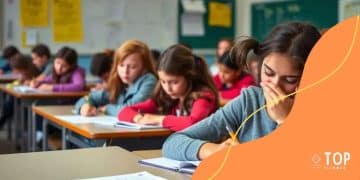Flipped classrooms: redefining homework and lectures

Flipped classrooms reverse traditional learning by having students engage with the material at home, enabling more interactive and collaborative activities in class, ultimately enhancing student engagement and personalized learning.
Flipped classrooms are changing the way we think about homework and lectures. By encouraging active participation, this innovative approach not only engages students but also enhances their learning experience. Have you ever wondered how this method could transform your own education?
Understanding flipped classrooms
Understanding flipped classrooms is essential for anyone interested in modern education practices. This innovative model challenges traditional learning by reversing the roles of in-class and at-home activities.
In a typical classroom setting, teachers deliver lectures while students listen and take notes. However, in a flipped classroom, students watch video lectures or review materials at home before class. This allows class time to be used for engaging activities, discussions, and hands-on projects.
Key Features of Flipped Classrooms
This approach fosters a more interactive learning environment. Here are some key features:
- Student-Centered Learning: The focus shifts to students actively participating in their own learning.
- Flexible Learning: Students can learn at their own pace, revisiting video lectures as needed.
- Enhanced Engagement: Class time is utilized for activities that reinforce understanding and encourage collaboration.
Moreover, teachers can tailor class time to address students’ needs and interests. This leads to more effective learning, as instructors can guide students through difficult concepts and encourage deeper exploration of subjects.
Benefits of Flipped Classrooms
There are several benefits to implementing flipped classrooms:
- Improved Retention: Studies show that students retain information better when they learn through active participation.
- Stronger Relationships: Teachers have more time to connect with students, fostering relationships that enhance learning.
- Accessibility: Students can access materials anytime, making learning more inclusive.
This model offers a creative approach to education, where knowledge becomes a shared experience in the classroom rather than a one-sided lecture. Ultimately, understanding flipped classrooms allows educators to adopt methods that meet the diverse needs of their students, making learning more effective and enjoyable.
Advantages of the flipped model
The flipped model offers numerous advantages that can enhance the educational experience for both students and teachers. One of the primary benefits is that it encourages active learning. When students engage with materials at home, they come to class prepared to participate in meaningful discussions and hands-on activities.
This shift from passive listening to active engagement allows students to take responsibility for their own learning. They are not just receiving information but exploring it through practical applications in the classroom.
Enhanced Learning Opportunities
The flipped model promotes enhanced learning opportunities. Here are a few key benefits:
- Greater Flexibility: Students can access learning materials anytime, allowing them to study at their own pace.
- More Class Interaction: Class time is spent on collaborative projects, which build teamwork skills.
- Instant Feedback: Teachers can provide immediate feedback and support during activities, helping students understand concepts better.
Additionally, the flipped classroom provides a unique platform for differentiated instruction. Teachers can tailor learning experiences to meet the diverse needs of students, ensuring that everyone receives the support they require.
Improved Student Engagement
Another significant advantage of the flipped model is improved student engagement. When students interact with content before class, they are more prepared to ask questions and participate actively. This deepens their understanding, as they feel empowered to explore topics of interest.
The model also allows for a variety of learning activities that cater to different learning styles. For example, visual learners can benefit from videos and infographics, while kinesthetic learners can participate in hands-on experiments during class time. Overall, this rich diversity in learning experiences keeps students motivated and invested in their education.
How to implement flipped classrooms

Implementing flipped classrooms can transform the learning environment and encourage student engagement. To start, it’s essential to prepare both students and teachers for this shift in teaching style.
First, educators should familiarize themselves with the necessary technology. Utilizing video platforms and learning management systems (LMS) is crucial. Teachers can begin by creating short, engaging video lectures or curated content that students can review at their convenience.
Steps to Implement Flipped Classrooms
Here are some steps to effectively implement flipped classrooms:
- Set Clear Expectations: Explain to students how the model works and what is expected of them both in and out of class.
- Choose Engaging Content: Select materials that interest students and encourage them to explore topics further.
- Create an Interactive Classroom: Design activities that promote collaboration and allow students to apply what they’ve learned from the videos.
Additionally, it’s important to encourage feedback from students. Understanding their perspective can help improve the effectiveness of the model. Teachers might find that certain materials work well while others do not, which can guide future lessons.
Adapting Traditional Curriculum
When adapting a traditional curriculum to a flipped classroom model, tweaking lesson plans is necessary. For instance, teachers should identify key topics to cover in video lectures and structure class time around them. This ensures that students receive targeted instruction and support during their active learning.
Encouraging students to prepare questions ahead of class fosters a culture of inquiry. When students arrive with specific questions, class discussions become more meaningful. Moreover, teachers can address these questions directly, enhancing comprehension and retention.
As teachers implement the flipped model, it’s essential for them to be flexible and adaptable. Monitoring student progress and adjusting strategies based on what works best for the class is a key part of the implementation process.
Challenges in adopting flipped classrooms
Adopting flipped classrooms can bring many benefits, but it also presents several challenges. Understanding these challenges is crucial for teachers looking to implement this innovative approach effectively.
One significant hurdle is resistance to change. Some educators may be accustomed to traditional teaching methods and may find it difficult to adapt to new strategies. This resistance can stem from a lack of training or comfort with technology.
Common Challenges of Flipped Classrooms
There are several common challenges faced when transitioning to a flipped classroom model:
- Technology Accessibility: Not all students may have access to the necessary technology at home, which can hinder their ability to complete assignments.
- Student Engagement: Some students may struggle with the idea of learning independently at home and may not take the assigned materials seriously.
- Preparation Time: Teachers need to invest time in creating engaging videos and materials, which can be daunting alongside their regular teaching workload.
Another major concern is ensuring that students are actually engaging with the content outside of class. Teachers must find ways to motivate students to complete pre-class assignments, as this directly impacts the effectiveness of in-class activities. Without preparation, discussions can become unproductive.
Balancing Class Dynamics
In a flipped classroom, balancing class dynamics can be challenging. Teachers need to create an environment where every student feels comfortable participating. It’s vital to foster a culture where students can ask questions and share ideas. This helps to build trust and encourages collaboration among peers.
Additionally, as students come from various backgrounds with different learning speeds, teachers must be prepared to provide additional support to those who need it. This may involve offering extra resources or one-on-one guidance to ensure that all students are on track.
Finally, educators need to assess student learning and adapt their methods accordingly. This ongoing evaluation can help identify which aspects of the flipped classroom are working and which need adjustments or rethinking.
Future trends in education with flipped classrooms
Future trends in education are being shaped significantly by the flipped classroom model. As technology evolves, this innovative approach is likely to become even more prominent in classrooms around the world.
One of the primary trends is the increasing use of technology in education. With advancements in video creation tools and learning management systems, teachers can create more engaging and interactive content for students. This not only enhances the learning experience but also makes it easier to track student progress.
Personalized Learning Experiences
The flipped classroom model supports personalized learning. Students can progress at their own pace, allowing them to spend extra time on challenging topics while moving quickly through areas they grasp easily. This flexibility caters to diverse learning styles and needs, which is essential for effective education.
Additionally, using data analytics, teachers can identify students’ strengths and weaknesses, enabling them to offer more tailored support. Personalized learning is expected to grow, providing more opportunities for each student to succeed.
Increased Collaboration and Communication
Future classrooms will likely emphasize even more on collaboration among students. The flipped classroom encourages students to work together during class time, fostering teamwork skills. This focus on collaboration prepares students for the collaborative nature of today’s workplaces.
Moreover, communication tools will continue to enhance the interaction between teachers and students. Online platforms facilitate easy communication for questions or feedback, making the learning process more responsive and dynamic.
As education continues to shift towards a more student-centered approach, the flipped classroom aligns perfectly with these trends. Educators will need to find new ways to keep content relevant and engaging, ensuring that students remain motivated and invested in their learning journeys.
In conclusion, the flipped classroom model is reshaping education in exciting ways. It promotes engagement, personalizes learning, and integrates technology effectively. As educators adapt to this approach, challenges will arise, but the benefits of fostering collaboration and critical thinking are immense. By leveraging advances in educational technology and creating dynamic learning environments, teachers can help students thrive in their academic journeys.
FAQ – Frequently Asked Questions about Flipped Classrooms
What is a flipped classroom?
A flipped classroom is an instructional strategy where traditional learning activities are reversed. Students learn content at home and engage in activities in class.
What are the key benefits of a flipped classroom?
Key benefits include increased student engagement, personalized learning experiences, and better use of class time for collaboration and discussion.
What challenges do teachers face when implementing flipped classrooms?
Challenges include technology access for students, resistance to change from traditional methods, and the need for preparation time for creating engaging content.
How can flipped classrooms prepare students for the future?
Flipped classrooms foster skills like self-directed learning, collaboration, and critical thinking, all of which are essential for success in today’s digital world.






